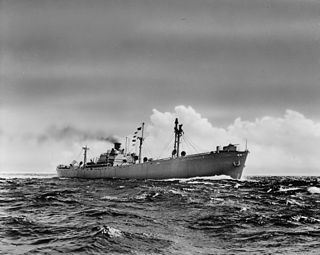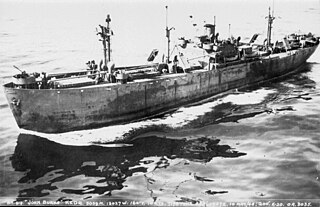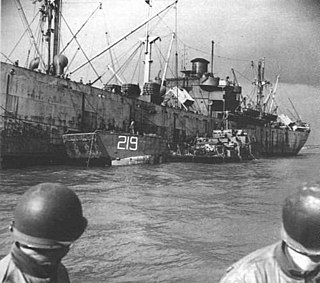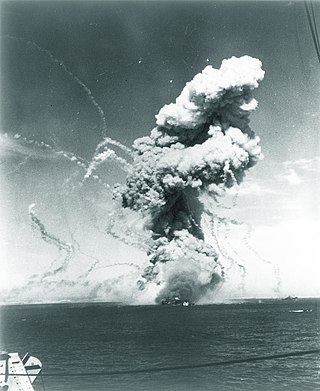SS Antoine Saugrain was a Liberty ship of the United States that served in World War II. The ship was built at the Permanente Metals Corporation Yard No. 2 in Richmond, California under Maritime Commission Contract 1728. Laid down on 26 July 1943, the ship was launched on 15 August, and delivered on 28 August to Agwilines Inc. She was named after Antoine Saugrain, a French physician and chemist who immigrated to America at the end of the 18th century and led various pioneering works, including on vaccination against smallpox.

SS Marcus Daly was a liberty ship built by the Kaiser Shipyards at their Permanente No.1 yard at Richmond, California, and launched on 24 July 1943.

SS John Burke was an American Liberty Ship built during World War II, one of the 2,710 type 'EC2-S-C1' ships that carried all kinds and types of dry cargo during the war. The ship was named for John Burke, the 10th Governor of North Dakota. Burke was built at Kaiser Shipbuilding Company's Oregon Shipbuilding yard in Portland, Oregon. Burke's keel was laid November 20, 1942 and the hull was launched on December 13. After fitting-out, Burke was delivered to the US Maritime Commission on December 23, just 33 days after construction began. The War Shipping Administration then placed Burke under management of the Northland Transportation Company.

SS William S. Ladd was an American Liberty ship built during World War II, one of the 2,710 type 'EC2-S-C1' ships that carried all kinds and types of dry cargo during the war. She was named for William S. Ladd, an American politician and businessman in Oregon, who twice served as Portland's mayor in the 1850s. The ship's keel was laid on August 29, 1943, and 15 days later, on September 13, the hull was launched. William S. Ladd was fitted out in seven days, and was delivered to the U.S. Navy on September 20. The Navy placed Ladd under charter to Weyerhaeuser Steamship Co.

SS Logan Victory was a cargo Victory ship built for World War II under the Emergency Shipbuilding program. The Logan Victory was launched January 16, 1945, by Permanente Metals Corporation, Richmond, California and completed on February 6, 1945. She was operated by the American-Hawaiian Steamship Company under the United States Maritime Commission.

SS Hobbs Victory was a cargo Victory ship built for World War II under the Emergency Shipbuilding program. Hobbs Victory, was launched on January 9, 1945 by Permanente Metals Corporation, Richmond, California and completed on January 9, 1945. She was built in just 87 days. She was operated by the Sudden & Christenson for the United States Maritime Commission.

SS Luxembourg Victory was a Victory ship built for the United States during World War II. She was launched by the Oregon Shipbuilding Corporation on February 28, 1944, and was completed on April 5, 1944. The ship's US Maritime Commission designation was VC2-S-AP3, hull number 90 (V-90). She was built in 101 days under the Emergency Shipbuilding program. The Maritime Commission turned her over to a civilian contractor, the Lykes Brothers SS Company, for operation until the end of World War II hostilities. She was operated under the US Merchant Marine Act for the War Shipping Administration.

SS Elmira Victory was a Victory ship built during World War II under the Emergency Shipbuilding program. It was built and launched by the Oregon Shipbuilding Corporation on May 12, 1944 and completed on May 31, 1944. The ship's United States Maritime Commission designation was VC2-S-AP3 and hull number 105 (1021). The ship was Oregon Shipbuilding Corporation's 21st victory ship. The Maritime Commission turned it over for Merchant navy operation to a civilian contractor, the Isthmian Steamship Company under the United States Merchant Marine act for the War Shipping Administration. She was named after the city of Elmira, New York.

The SS Saginaw Victory was a Victory ship built during World War II under the Emergency Shipbuilding program. It was laid down and launched by the Oregon Shipbuilding Corporation, and completed on February 9, 1945. The ship's United States Maritime Commission designation was VC2-S-AP3 and hull number 152. The Maritime Commission turned it over for merchant navy operation to a civilian contractor, the Pacific-Atlantic Steamship Company under the United States Merchant Marine act for the War Shipping Administration. She was named after Saginaw, Michigan. Victory ships were designed to supersede the earlier Liberty ships. Unlike Liberty ships, Victory ships were designed to serve the US Navy after the war and to last longer. Compared to Liberty ships, Victory ships were faster, longer, wider, taller, and had a thinner stack which was set further forward on the superstructure. They also had a long, raised forecastle.

The SS Berea Victory (MCV-734) was a type VC2-S-AP2 Victory-class cargo ship built for the United States during World War II. The ship was built as part of the Emergency Shipbuilding program by Permanente Metals Corporation in Yard 2 of the Richmond Shipyards in Richmond, California. Launched on 3 March 1945, the Berea Victory delivered supplies for the Pacific War.

The SS Pierre Victory was a Victory ship built during World War II under the Emergency Shipbuilding program. It was laid down and launched by the Oregon Shipbuilding Corporation, and completed on February 5, 1945. The ship's United States Maritime Commission designation was VC2-S-AP3 and hull number 150. The Maritime Commission turned it over for merchant navy operation to a civilian contractor, the United States Lines under the United States Merchant Marine act for the War Shipping Administration. She was named after Pierre, South Dakota, the capital of the US state of South Dakota. The sponsor and christening of the SS Pierre Victory on Dec. 6, 1944 was Mrs. Emma S. Jassmann of Pierre, she had five sons who served during World War II,. The city of Pierre and the Pierre Chamber of Commerce sent Mrs. Jassmann to Oregon. The Mayor of City of Pierre, John B. Griffin, was also at the christening with other Pierre residents. She was built in only 98 days. Victory ships were designed to supersede the earlier Liberty ships. Unlike Liberty ships, Victory ships were designed to serve the US Navy after the war and to last longer. Compared to Liberty ships, Victory ships were faster, longer, wider, taller, and had a thinner stack which was set further forward on the superstructure. They also had a long, raised forecastle. SS Pierre Victory survived three separate kamikaze attacks by the Japanese in 1945.
SS Thomas Nelson was a Liberty ship built in the United States during World War II. She was named after Thomas Nelson, an American planter, soldier, and statesman from Yorktown, Virginia. He represented Virginia in the Continental Congress and was its Governor in 1781. He is regarded as one of the Founding Fathers of the United States. He signed the United States Declaration of Independence as a member of the Virginia delegation and fought in the militia during the Siege of Yorktown.

SS Alexander Majors was a Liberty ship built for the United States Maritime Commission during World War II. The ship was named in honor of Alexander Majors an American who with William Hepburn Russell and William B. Waddell founded the Pony Express. The ship was assigned by the War Shipping Administration to Isthmian Steamship Company of New York who operated it throughout World War 2. Alexander Majors was Laid down on 27 December 1943, launched on 20 January 1944 and completed on 4 March 1944, with the hull No. 2262 as part of the Emergency Shipbuilding Program.

SS Benjamin Ide Wheeler was a Liberty ship, a cargo ship during World War II. Built by California Shipbuilding Corporation (Calship) of Los Angeles for the United States Maritime Commission (USMC). Benjamin Ide Wheeler was Calship's 100th ship built. She was sponsored and christened by Mrs. Robert Gordon Sproul, wife of Robert Gordon Sproul President of the University of California system. She was named after Benjamin Ide Wheeler President of the University of California from 1899 to 1919. Her Hull # was 675, she was type EC2-S-C1 ship, built in 50 days as part of the Emergency Shipbuilding Program. Her keel was laid down on 28 October 1942, launched on 27 November 1942 and delivered on 17 December 1942. She was assigned to American-Hawaiian Steamship Company of San Francisco for merchant operation by the War Shipping Administration (WSA).

SS Hobart Baker was a Liberty ship built for the United States Maritime Commission during World War II. The ship was named in honor of Hobart Baker. Hobart "Hobey" Baker (1892–1918) was an American amateur athlete and is considered the first American star in ice hockey. He was also an American football player. The ship was assigned by the War Shipping Administration to General Steamship Company of San Francisco who operated it throughout World War II. Hobart Baker was laid down on 16 April 1943, launched on 12 May 1943 and completed on 24 May 1943, with the hull No. 1114 as part of the Emergency Shipbuilding Program, built is 38 days.

SS Lewis L. Dyche was a Liberty ship built by the Oregon Shipbuilding Corporation for the United States Maritime Commission during World War II. The ship was named in honor of Lewis Lindsay Dyche. Lewis Lindsay Dyche (1857–1915) was an American naturalist and also the creator of the Panorama of North American Plants and Animals, which was featured in the Kansas Pavilion at the 1893 World's Columbian Exposition. The ship was assigned by the War Shipping Administration, she operated by Interocean Steamship Company of San Francisco during World War II. Lewis L. Dyche was laid down on 6 November 1943, launched on 26 November 1943 and completed on 9 December 1943, with the hull No. 807 as part of the Emergency Shipbuilding Program, built is 38 days.

SS Robert Rowan was an American Liberty ship built in 1943 for service in World War II. Her namesake was Robert Rowan, an American politician.
Weyerhaeuser Steamship Company was a cargo Liner company founded in Tacoma, Washington. Weyerhaeuser Steamship Company was founded by Weyerhaeuser Company in 1933. Weyerhaeuser is one of the largest lumber and paper companies in the United States. First called the Weyerhaeuser Timber Company which started with ships for towing logs in the Northwestern United States. Weyerhaeuser started Weyerhaeuser Timber Company with a ship he acquired in 1892. The log towing ship was a 140-foot sternwheeler built for the partnership, Weyerhaeuser and Denkman Company. In 1923 Weyerhaeuser added to ocean lumber cargo ship the SS Pomona and the SS Hanley. The two ships took lumber to the East Coast. In 1933 F. Weyerhaeuser starts the Weyerhaeuser Steamship Company and moves the headquarters to Newark, New Jersey. At the outbreak of World War II the US government orders the four Weyerhaeuser to take supplies to the British army in Egypt. The next year the other four company's ships are requisitioned by the War Shipping Administration. During World War II the Weyerhaeuser Steamship Company was active in charter shipping with the Maritime Commission and War Shipping Administration. During wartime, the Weyerhaeuser Steamship Company operated Victory ships and Liberty shipss. The ship was run by its crew and the US Navy supplied United States Navy Armed Guards to man the deck guns and radio. The most common armament mounted on these merchant ships were the MK II 20mm Oerlikon autocannon and the 3"/50, 4"/50, and 5"/38 deck guns. In 1942 the SS Potlatch and the SS Heffron were sunk by German U-boats torpedoes. After the war, Weyerhaeuser Steamship Company purchased four Liberty ships for intercoastal shipping service. In 1950 Weyerhaeuser Steamship Company purchases the Pacific Coast Direct Line and moves its headquarter from Newark to San Francisco. In 1962 the Weyerhaeuser Line is started and Weyerhaeuser Steamship becomes a division of Weyerhaeuser Company.
Northland Transportation Company operated cargo and passenger ships from Seattle to Southeast Alaska starting in 1923. During World War II Northland Transportation Company was active in charter shipping with the Maritime Commission and War Shipping Administration. Northland Transportation Company, proposed a loan from United States Shipping Board to build a ship for Puget Sound-Alaska trade in 1933. In 1934, the company was granted a $350,000 loan to build a new ship. The 1,400 tons passenger ship, was built at Lake Washington Shipyard in Houghton, Washington. Northland Transportation Company Seattle dock and warehouse were at Pier 56, now Ainsworth and Dunn Wharf.

World War II United States Merchant Navy was the largest civilian Navy in the world, which operated during World War II. With the United States fighting a world war in all the world oceans, the demand for cargo and fuel was very high. Cargo and fuel was needed around the world for the United States Navy, United States Army, United States Marine Corps, United States Army Air Forces, United States Coast Guard and the support of the allied nations of the United States. American steamship companies chartered ships from the Maritime Commission and War Shipping Administration to meet the demand. Many United States Merchant Marine ships were newly built in the Emergency Shipbuilding Program, other ships were older World War I ships that were put back in service, or private ships acquired under Emergency war requisitions. The Merchant Navy operated in the Pacific War and European war. Over 200 US Merchant ships took part in the D-day Normandy landings. To make a Normandy breakwater Harbor, called Mulberry harbour, 33 merchant ships were sunk 1,000 yards from shore. Some of the ghosts merchant ships used were damaged and others were deemed too old.







